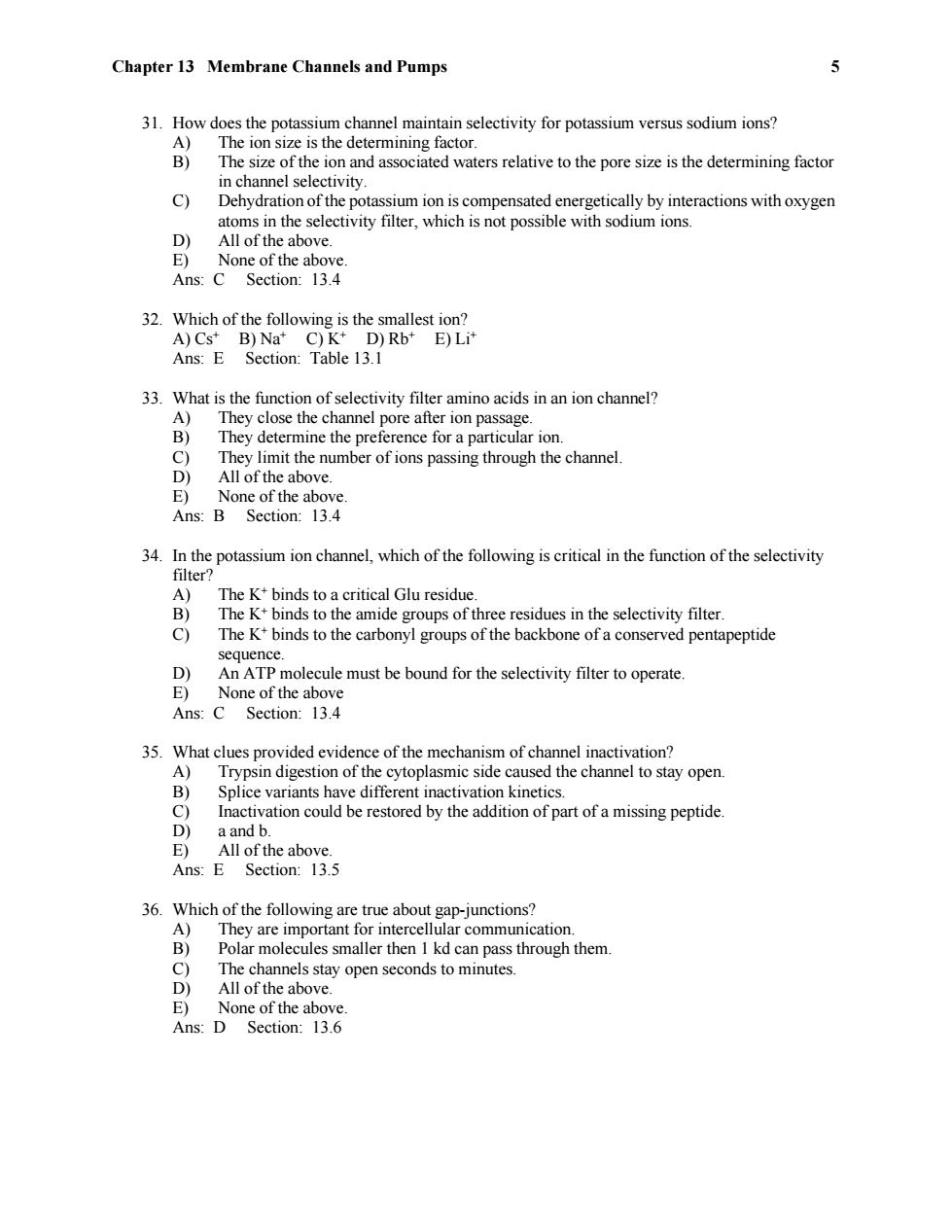正在加载图片...

Chapter 13 Membrane Channels and Pumps 31.How does the potassium channel maintain selectivity for potassium versus sodium ions? A) The ion size is the determining factor. B) The size of the ion and associated waters relative to the pore size is the determining factor in channel selectivity. c) Dehydration of the potassium ion is compensated energetically by interactions with oxygen atoms in the selectivity filter,which is not possible with sodium ions. D) All of the above. E) None of the above. Ans:C Section:13.4 32.Which of the following is the smallest ion? A)Cs*B)Na+C)K+D)Rb+E)Lit Ans:E Section:Table 13.1 33.What is the function of selectivity filter amino acids in an ion channel? A)They close the channel pore after ion passage. B) They determine the preference for a particular ion. C) They limit the number of ions passing through the channel. D) All of the above. E) None of the above. Ans:B Section:13.4 34.In the potassium ion channel,which of the following is critical in the function of the selectivity filter? A The K+binds to a critical Glu residue. B) The K+binds to the amide groups of three residues in the selectivity filter. C) The K+binds to the carbonyl groups of the backbone of a conserved pentapeptide sequence. D) An ATP molecule must be bound for the selectivity filter to operate. E) None of the above Ans:C Section:13.4 35.What clues provided evidence of the mechanism of channel inactivation? A)Trypsin digestion of the cytoplasmic side caused the channel to stay open. B) Splice variants have different inactivation kinetics. C) Inactivation could be restored by the addition of part of a missing peptide. D) a and b. E)All of the above. Ans:E Section:13.5 36.Which of the following are true about gap-junctions? A)They are important for intercellular communication. B) Polar molecules smaller then 1 kd can pass through them. C) The channels stay open seconds to minutes. D)All of the above. E)None of the above. Ans:D Section:13.6Chapter 13 Membrane Channels and Pumps 5 31. How does the potassium channel maintain selectivity for potassium versus sodium ions? A) The ion size is the determining factor. B) The size of the ion and associated waters relative to the pore size is the determining factor in channel selectivity. C) Dehydration of the potassium ion is compensated energetically by interactions with oxygen atoms in the selectivity filter, which is not possible with sodium ions. D) All of the above. E) None of the above. Ans: C Section: 13.4 32. Which of the following is the smallest ion? A) Cs + B) Na + C) K+ D) Rb + E) Li+ Ans: E Section: Table 13.1 33. What is the function of selectivity filter amino acids in an ion channel? A) They close the channel pore after ion passage. B) They determine the preference for a particular ion. C) They limit the number of ions passing through the channel. D) All of the above. E) None of the above. Ans: B Section: 13.4 34. In the potassium ion channel, which of the following is critical in the function of the selectivity filter? A) The K+ binds to a critical Glu residue. B) The K+ binds to the amide groups of three residues in the selectivity filter. C) The K+ binds to the carbonyl groups of the backbone of a conserved pentapeptide sequence. D) An ATP molecule must be bound for the selectivity filter to operate. E) None of the above Ans: C Section: 13.4 35. What clues provided evidence of the mechanism of channel inactivation? A) Trypsin digestion of the cytoplasmic side caused the channel to stay open. B) Splice variants have different inactivation kinetics. C) Inactivation could be restored by the addition of part of a missing peptide. D) a and b. E) All of the above. Ans: E Section: 13.5 36. Which of the following are true about gap-junctions? A) They are important for intercellular communication. B) Polar molecules smaller then 1 kd can pass through them. C) The channels stay open seconds to minutes. D) All of the above. E) None of the above. Ans: D Section: 13.6